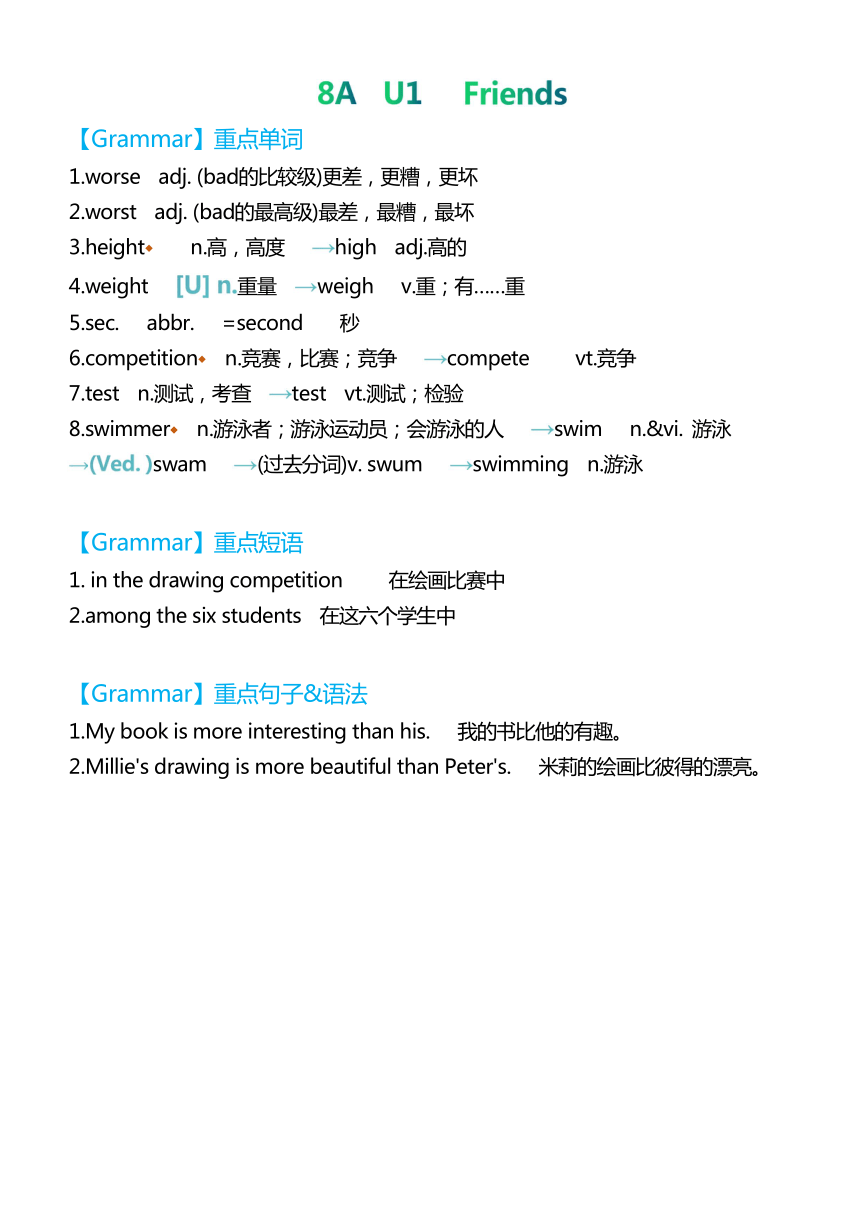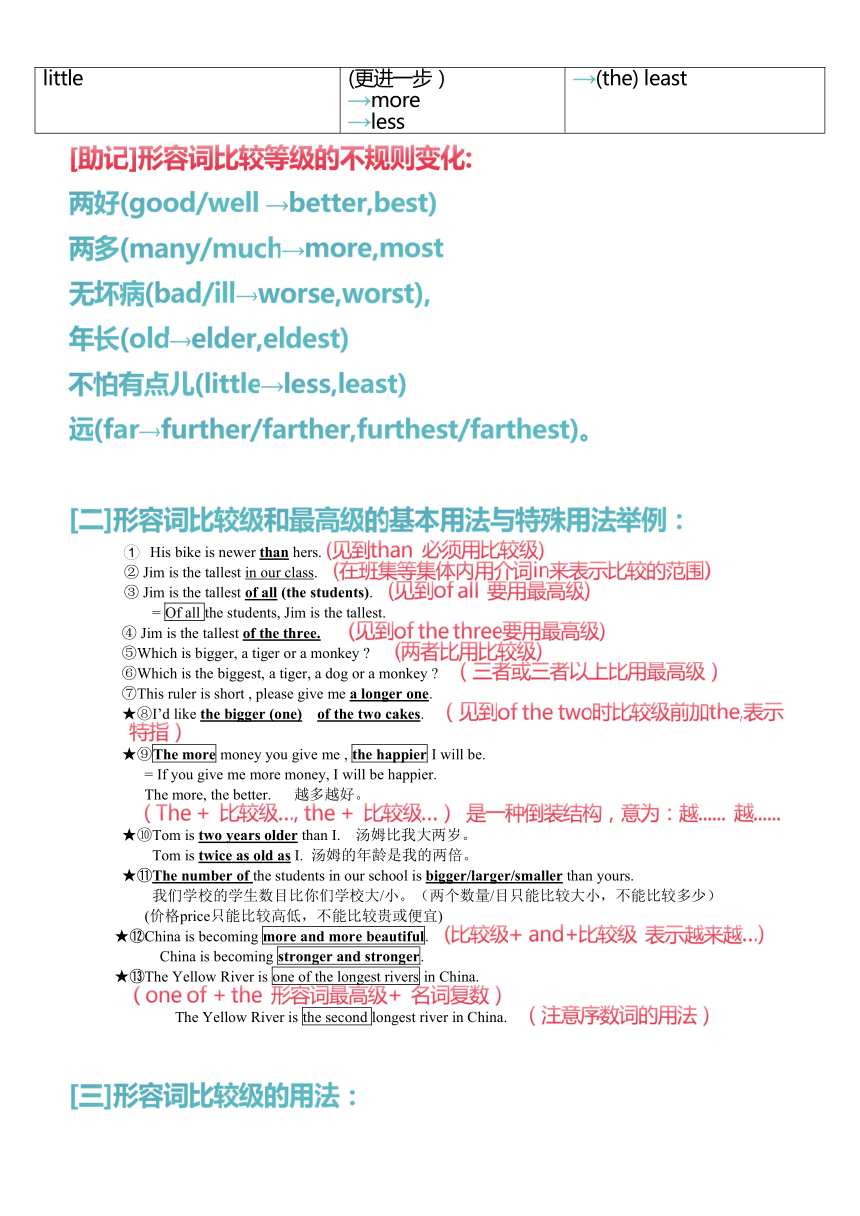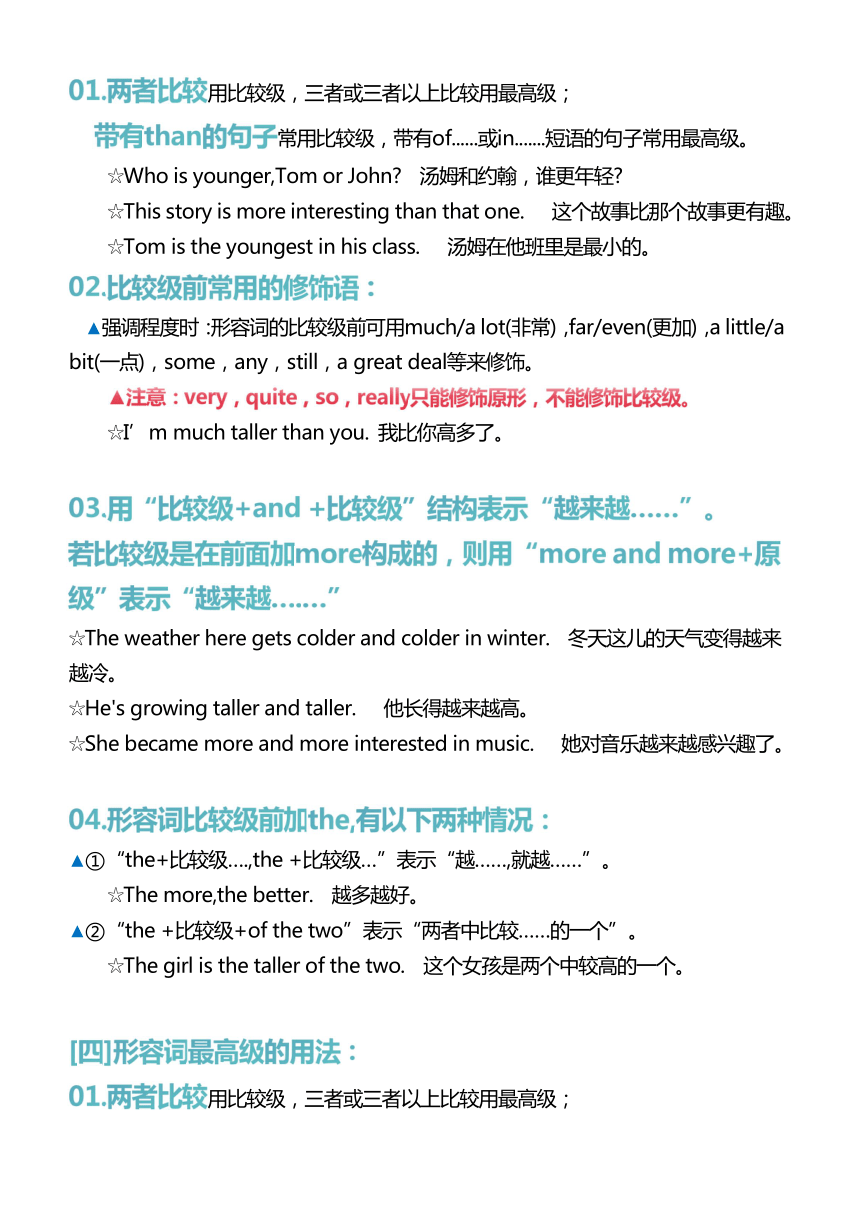Unit1 Friends- grammar 知识点讲义 2023-2024学年牛津译林版英语八年级上册
文档属性
| 名称 | Unit1 Friends- grammar 知识点讲义 2023-2024学年牛津译林版英语八年级上册 |

|
|
| 格式 | docx | ||
| 文件大小 | 95.9KB | ||
| 资源类型 | 教案 | ||
| 版本资源 | 牛津译林版 | ||
| 科目 | 英语 | ||
| 更新时间 | 2024-06-29 11:30:34 | ||
图片预览




文档简介
8A U1 Friends
【Grammar】重点单词
1.worse adj. (bad的比较级)更差,更糟,更坏
2.worst adj. (bad的最高级)最差,最糟,最坏
3.height◆ n.高,高度 →high adj.高的
4.weight [U] n.重量 →weigh v.重;有……重
5.sec. abbr. =second 秒
6.competition◆ n.竞赛,比赛;竞争 →compete vt.竞争
7.test n.测试,考查 →test vt.测试;检验
8.swimmer◆ n.游泳者;游泳运动员;会游泳的人 →swim n.&vi. 游泳
→(Ved. )swam →(过去分词)v. swum →swimming n.游泳
【Grammar】重点短语
1. in the drawing competition 在绘画比赛中
2.among the six students 在这六个学生中
【Grammar】重点句子&语法
1.My book is more interesting than his. 我的书比他的有趣。
2.Millie's drawing is more beautiful than Peter's. 米莉的绘画比彼得的漂亮。
Grammar:形容词比较级和最高级
Grammar:形容词比较级和最高级——精讲
[一]形容词比较级和最高级的构成:
Adjective (形容词) Comparative(比较级) Superlative(最高级)
①大多数短形容词(少于或等于两个音节) +er +est
tall small → taller → smaller →(the) tallest →(the) smallest
②以e结尾的短形容词 +r +st
nice fine → nicer → finer → (the) nicest → (the) finest
③以辅音字母+y结尾的短形容词 -y +ier -y +iest
pretty easy → prettier → easier → (the) prettiest → (the) easiest
④以元音字母+辅音字母结尾的短形容词 double the consonant +er (双写辅音字母再+er) double the consonant +est (双写辅音字母再+est)
slim big fat hot sad thin red → slimmer → bigger → fatter → hotter → sadder → thinner → redder → (the) slimmest → (the) biggest → (the) fattest → (the) hottest → (the) saddest → (the) thinnest → (the) reddest
⑤长形容词,一般超过2个音节 + more/less +most/least
beautiful interesting important → more/less beautiful → more/less interesting → more/less important → (the) most/least beautiful → (the) most/least interesting → (the) most/least important
⑥特殊的形容词 替换这个词 替换这个词
good/well bad/ill/badly old far much/many little →better →worse →older/elder(年长的) →farther/further (更进一步) →more →less →(the) best →(the) worst →(the) oldest/eldest →(the) farthest/furthest →(the) most →(the) least
[助记]形容词比较等级的不规则变化:
两好(good/well →better,best)
两多(many/much→more,most
无坏病(bad/ill→worse,worst),
年长(old→elder,eldest)
不怕有点儿(little→less,least)
远(far→further/farther,furthest/farthest)。
[二]形容词比较级和最高级的基本用法与特殊用法举例:
His bike is newer than hers. (见到than 必须用比较级)
② Jim is the tallest in our class. (在班集等集体内用介词in来表示比较的范围) ③ Jim is the tallest of all (the students). (见到of all 要用最高级)
= Of all the students, Jim is the tallest.
④ Jim is the tallest of the three. (见到of the three要用最高级)
⑤Which is bigger, a tiger or a monkey (两者比用比较级)
⑥Which is the biggest, a tiger, a dog or a monkey (三者或三者以上比用最高级)
⑦This ruler is short , please give me a longer one.
★⑧I’d like the bigger (one) of the two cakes. (见到of the two时比较级前加the,表示特指)
★⑨The more money you give me , the happier I will be.
= If you give me more money, I will be happier.
The more, the better. 越多越好。
(The + 比较级…, the + 比较级…) 是一种倒装结构,意为:越...... 越......
★⑩Tom is two years older than I. 汤姆比我大两岁。
Tom is twice as old as I. 汤姆的年龄是我的两倍。
★ The number of the students in our school is bigger/larger/smaller than yours.
我们学校的学生数目比你们学校大/小。(两个数量/目只能比较大小,不能比较多少)
(价格price只能比较高低,不能比较贵或便宜)
★ China is becoming more and more beautiful. (比较级+ and+比较级 表示越来越…)
China is becoming stronger and stronger.
★ The Yellow River is one of the longest rivers in China.
(one of + the 形容词最高级+ 名词复数)
The Yellow River is the second longest river in China. (注意序数词的用法)
[三]形容词比较级的用法:
01.两者比较用比较级,三者或三者以上比较用最高级;
带有than的句子常用比较级,带有of......或in.......短语的句子常用最高级。
☆Who is younger,Tom or John 汤姆和约翰,谁更年轻
☆This story is more interesting than that one. 这个故事比那个故事更有趣。
☆Tom is the youngest in his class. 汤姆在他班里是最小的。
02.比较级前常用的修饰语:
▲强调程度时:形容词的比较级前可用much/a lot(非常),far/even(更加),a little/a bit(一点),some,any,still,a great deal等来修饰。
▲注意:very,quite,so,really只能修饰原形,不能修饰比较级。
☆I’m much taller than you. 我比你高多了。
03.用“比较级+and +比较级”结构表示“越来越……”。
若比较级是在前面加more构成的,则用“more and more+原级”表示“越来越….…”
☆The weather here gets colder and colder in winter. 冬天这儿的天气变得越来越冷。
☆He's growing taller and taller. 他长得越来越高。
☆She became more and more interested in music. 她对音乐越来越感兴趣了。
04.形容词比较级前加the,有以下两种情况:
▲①“the+比较级….,the +比较级…”表示“越……,就越……”。
☆The more,the better. 越多越好。
▲②“the +比较级+of the two”表示“两者中比较……的一个”。
☆The girl is the taller of the two. 这个女孩是两个中较高的一个。
[四]形容词最高级的用法:
01.两者比较用比较级,三者或三者以上比较用最高级;
带有than的句子常用比较级,带有of......或in.......短语的句子常用最高级。
02.“one of the+形容词最高级+可数名词复数”表示“最……的……之一
☆Shanghai is one of the most beautiful cities in China. 上海是中国最美丽的城市之一。
03.形容词最高级前通常要加the。但当形容词最高级前有序数词、物主代词、指示代词、名词所有格等限定词修饰时,最高级前不加the。
☆He is our best teacher. 他是我们最好的老师。
04.最高级后面往往用of..或in…短语来表示形容词的最高级的比较范围。of后所接内容与主语是同类事物,而in后接表示范围的词语。
☆He is the youngest of the three. 他是三者中最年轻的。
☆I'm the shortest in my family. 我是家里最矮的。
05.“the+序数词+最高级”意为“第……最……。
☆The Changjiang River is the third longest river in the world. 长江是世界第三长河。
[五]使用形容词和副词比较级和最高级应注意事项:
1. than必须放在形容词比较级的后面。
2.形容词的最高级前必须有the, 而副词的最高级前the可以省略。
3.在进行比较时,必须是同类事物相比较。
[六]以—ful/—less/—ed/—ing/—ous/—tive等后缀结尾的形容词,由形容词加ly构成的副词,无论是长还是短,一律比较级加more, 最高级加the most。
famous→more famous→the most famous active→ more active →the most active
useful→more useful→the most useful bored→more bored→the most bored
boring→more boring→the most boring careless→more careless→the most careless
excited→more excited→the most excited slowly→more slowly→ (the) most slowly
[七]形容词最高级与比较级的互换:
▲the +形容词最高级+单数名词(+范围)
= 形容词比较级+than any other +单数名词(+范围)
= 形容词比较级+than the other+复数名词(+范围),
即用比较级的形式表示最高级的概念。
Tom is the tallest boy in the class.=Tom is taller than any other boy in the class.
=Tom is taller than the other boys in the class.
汤姆是班上个子最高的男孩。
Grammar——Key points
01.worse
[教材语境] worse 更差 (教材第11页)
[考点精析] worse此处用作形容词,意为“更差,更糟,更坏”,是bad的比较级,用于两者之间进行比较,可加much进行强调。
☆I have a worse garden than you have. 我有一个比你的更差的花园。
☆Your homework is bad,but Lily's is much worse. 你的家庭作业不好,但莉莉的更糟。
[联想拓展] ▲①worse还可用作副词,意为“更坏地,更糟地”,是badly的比较级。
☆He did worse this time. 这次他做得更差。
▲②worst是bad/badly的最高级,意为“最差,最糟,最坏”。
☆He is the worst of the three. 在三个人中他是最差的。
☆I sing the worst in our class. 在我们班我唱得最差。
02.height
[教材语境] Height (身)高 (教材第12页)
[考点精析] height既可作 [C] n.& [U] n.,意为“高,高度”,指人或物的高度。
◆the height of... ……的高度
◆in height 在高度上
☆The height of the house is about 5 metres. 这所房子大约5米高。
☆What's your height 你身高多少
[词形变化] height [C] n.& [U] n.高,高度◆ →high adj.高的;高等的
→highly adv.高度地;高地
◆think highly of 高度评价
03.weight
[教材语境] Weight(kg) (体)重(千克) (教材第12页)
[考点精析] weight用作不可数名词[U] n.,意为“重量”。
▲提问重量可用what或how much。
☆What's his weight /How much does he weigh 他有多重
◆the weight of ……的重量
◆put on weight 发胖,增肥 ◆lose weight 减肥 ◆take one's weight 称体重
☆—What's the weight of the wooden box 这个木箱有多重 —Fifty kilos. 50千克重。
☆What is your weight 你的体重是多少
[联想拓展] weight的动词形式是weigh,意为“重……;称……的重量”。
☆It weighs nearly 27 kilos. 它重近27千克。
☆How much do you weigh 你体重多少
◆put on weight 发胖,增肥
◆lose weight 减肥
◆take one's weight 称体重
【拓展提升——weigh——8A U3 comic & welcome】
[教材语境] Yes,and it weighs over 100,000 tons.
是的,它的重量超过了100000吨。(教材第31页)
[考点精析] ▲①weigh此处用作动词,意为“重;有…重”。
☆The baby weighed about 5 kilograms. 这个婴儿重约5千克。
▲②weigh还可用作及物动词,意为“称……的重量”。
☆He wants to weigh the cotton. 他想称称这些棉花的重量。
04.Among
[教材语境] Among the six students... 在六个学生中… (教材第12页)
[考点精析] among 在(三者或三者以上)之间;between 在(两者)之间
◆between ...and... 在.....和.....之间
[常考辨析] among 与 between
易混词汇 含义及用法
among 强调在三者或三者以上之间
between 强调在两者之间;后接三者或三者以上的人或事物时,指每两之间。
☆There's a house among the green trees. 绿树间有一所房子。
☆The is a door between the windows. 在窗户之间有一扇门。
【Grammar】重点单词
1.worse adj. (bad的比较级)更差,更糟,更坏
2.worst adj. (bad的最高级)最差,最糟,最坏
3.height◆ n.高,高度 →high adj.高的
4.weight [U] n.重量 →weigh v.重;有……重
5.sec. abbr. =second 秒
6.competition◆ n.竞赛,比赛;竞争 →compete vt.竞争
7.test n.测试,考查 →test vt.测试;检验
8.swimmer◆ n.游泳者;游泳运动员;会游泳的人 →swim n.&vi. 游泳
→(Ved. )swam →(过去分词)v. swum →swimming n.游泳
【Grammar】重点短语
1. in the drawing competition 在绘画比赛中
2.among the six students 在这六个学生中
【Grammar】重点句子&语法
1.My book is more interesting than his. 我的书比他的有趣。
2.Millie's drawing is more beautiful than Peter's. 米莉的绘画比彼得的漂亮。
Grammar:形容词比较级和最高级
Grammar:形容词比较级和最高级——精讲
[一]形容词比较级和最高级的构成:
Adjective (形容词) Comparative(比较级) Superlative(最高级)
①大多数短形容词(少于或等于两个音节) +er +est
tall small → taller → smaller →(the) tallest →(the) smallest
②以e结尾的短形容词 +r +st
nice fine → nicer → finer → (the) nicest → (the) finest
③以辅音字母+y结尾的短形容词 -y +ier -y +iest
pretty easy → prettier → easier → (the) prettiest → (the) easiest
④以元音字母+辅音字母结尾的短形容词 double the consonant +er (双写辅音字母再+er) double the consonant +est (双写辅音字母再+est)
slim big fat hot sad thin red → slimmer → bigger → fatter → hotter → sadder → thinner → redder → (the) slimmest → (the) biggest → (the) fattest → (the) hottest → (the) saddest → (the) thinnest → (the) reddest
⑤长形容词,一般超过2个音节 + more/less +most/least
beautiful interesting important → more/less beautiful → more/less interesting → more/less important → (the) most/least beautiful → (the) most/least interesting → (the) most/least important
⑥特殊的形容词 替换这个词 替换这个词
good/well bad/ill/badly old far much/many little →better →worse →older/elder(年长的) →farther/further (更进一步) →more →less →(the) best →(the) worst →(the) oldest/eldest →(the) farthest/furthest →(the) most →(the) least
[助记]形容词比较等级的不规则变化:
两好(good/well →better,best)
两多(many/much→more,most
无坏病(bad/ill→worse,worst),
年长(old→elder,eldest)
不怕有点儿(little→less,least)
远(far→further/farther,furthest/farthest)。
[二]形容词比较级和最高级的基本用法与特殊用法举例:
His bike is newer than hers. (见到than 必须用比较级)
② Jim is the tallest in our class. (在班集等集体内用介词in来表示比较的范围) ③ Jim is the tallest of all (the students). (见到of all 要用最高级)
= Of all the students, Jim is the tallest.
④ Jim is the tallest of the three. (见到of the three要用最高级)
⑤Which is bigger, a tiger or a monkey (两者比用比较级)
⑥Which is the biggest, a tiger, a dog or a monkey (三者或三者以上比用最高级)
⑦This ruler is short , please give me a longer one.
★⑧I’d like the bigger (one) of the two cakes. (见到of the two时比较级前加the,表示特指)
★⑨The more money you give me , the happier I will be.
= If you give me more money, I will be happier.
The more, the better. 越多越好。
(The + 比较级…, the + 比较级…) 是一种倒装结构,意为:越...... 越......
★⑩Tom is two years older than I. 汤姆比我大两岁。
Tom is twice as old as I. 汤姆的年龄是我的两倍。
★ The number of the students in our school is bigger/larger/smaller than yours.
我们学校的学生数目比你们学校大/小。(两个数量/目只能比较大小,不能比较多少)
(价格price只能比较高低,不能比较贵或便宜)
★ China is becoming more and more beautiful. (比较级+ and+比较级 表示越来越…)
China is becoming stronger and stronger.
★ The Yellow River is one of the longest rivers in China.
(one of + the 形容词最高级+ 名词复数)
The Yellow River is the second longest river in China. (注意序数词的用法)
[三]形容词比较级的用法:
01.两者比较用比较级,三者或三者以上比较用最高级;
带有than的句子常用比较级,带有of......或in.......短语的句子常用最高级。
☆Who is younger,Tom or John 汤姆和约翰,谁更年轻
☆This story is more interesting than that one. 这个故事比那个故事更有趣。
☆Tom is the youngest in his class. 汤姆在他班里是最小的。
02.比较级前常用的修饰语:
▲强调程度时:形容词的比较级前可用much/a lot(非常),far/even(更加),a little/a bit(一点),some,any,still,a great deal等来修饰。
▲注意:very,quite,so,really只能修饰原形,不能修饰比较级。
☆I’m much taller than you. 我比你高多了。
03.用“比较级+and +比较级”结构表示“越来越……”。
若比较级是在前面加more构成的,则用“more and more+原级”表示“越来越….…”
☆The weather here gets colder and colder in winter. 冬天这儿的天气变得越来越冷。
☆He's growing taller and taller. 他长得越来越高。
☆She became more and more interested in music. 她对音乐越来越感兴趣了。
04.形容词比较级前加the,有以下两种情况:
▲①“the+比较级….,the +比较级…”表示“越……,就越……”。
☆The more,the better. 越多越好。
▲②“the +比较级+of the two”表示“两者中比较……的一个”。
☆The girl is the taller of the two. 这个女孩是两个中较高的一个。
[四]形容词最高级的用法:
01.两者比较用比较级,三者或三者以上比较用最高级;
带有than的句子常用比较级,带有of......或in.......短语的句子常用最高级。
02.“one of the+形容词最高级+可数名词复数”表示“最……的……之一
☆Shanghai is one of the most beautiful cities in China. 上海是中国最美丽的城市之一。
03.形容词最高级前通常要加the。但当形容词最高级前有序数词、物主代词、指示代词、名词所有格等限定词修饰时,最高级前不加the。
☆He is our best teacher. 他是我们最好的老师。
04.最高级后面往往用of..或in…短语来表示形容词的最高级的比较范围。of后所接内容与主语是同类事物,而in后接表示范围的词语。
☆He is the youngest of the three. 他是三者中最年轻的。
☆I'm the shortest in my family. 我是家里最矮的。
05.“the+序数词+最高级”意为“第……最……。
☆The Changjiang River is the third longest river in the world. 长江是世界第三长河。
[五]使用形容词和副词比较级和最高级应注意事项:
1. than必须放在形容词比较级的后面。
2.形容词的最高级前必须有the, 而副词的最高级前the可以省略。
3.在进行比较时,必须是同类事物相比较。
[六]以—ful/—less/—ed/—ing/—ous/—tive等后缀结尾的形容词,由形容词加ly构成的副词,无论是长还是短,一律比较级加more, 最高级加the most。
famous→more famous→the most famous active→ more active →the most active
useful→more useful→the most useful bored→more bored→the most bored
boring→more boring→the most boring careless→more careless→the most careless
excited→more excited→the most excited slowly→more slowly→ (the) most slowly
[七]形容词最高级与比较级的互换:
▲the +形容词最高级+单数名词(+范围)
= 形容词比较级+than any other +单数名词(+范围)
= 形容词比较级+than the other+复数名词(+范围),
即用比较级的形式表示最高级的概念。
Tom is the tallest boy in the class.=Tom is taller than any other boy in the class.
=Tom is taller than the other boys in the class.
汤姆是班上个子最高的男孩。
Grammar——Key points
01.worse
[教材语境] worse 更差 (教材第11页)
[考点精析] worse此处用作形容词,意为“更差,更糟,更坏”,是bad的比较级,用于两者之间进行比较,可加much进行强调。
☆I have a worse garden than you have. 我有一个比你的更差的花园。
☆Your homework is bad,but Lily's is much worse. 你的家庭作业不好,但莉莉的更糟。
[联想拓展] ▲①worse还可用作副词,意为“更坏地,更糟地”,是badly的比较级。
☆He did worse this time. 这次他做得更差。
▲②worst是bad/badly的最高级,意为“最差,最糟,最坏”。
☆He is the worst of the three. 在三个人中他是最差的。
☆I sing the worst in our class. 在我们班我唱得最差。
02.height
[教材语境] Height (身)高 (教材第12页)
[考点精析] height既可作 [C] n.& [U] n.,意为“高,高度”,指人或物的高度。
◆the height of... ……的高度
◆in height 在高度上
☆The height of the house is about 5 metres. 这所房子大约5米高。
☆What's your height 你身高多少
[词形变化] height [C] n.& [U] n.高,高度◆ →high adj.高的;高等的
→highly adv.高度地;高地
◆think highly of 高度评价
03.weight
[教材语境] Weight(kg) (体)重(千克) (教材第12页)
[考点精析] weight用作不可数名词[U] n.,意为“重量”。
▲提问重量可用what或how much。
☆What's his weight /How much does he weigh 他有多重
◆the weight of ……的重量
◆put on weight 发胖,增肥 ◆lose weight 减肥 ◆take one's weight 称体重
☆—What's the weight of the wooden box 这个木箱有多重 —Fifty kilos. 50千克重。
☆What is your weight 你的体重是多少
[联想拓展] weight的动词形式是weigh,意为“重……;称……的重量”。
☆It weighs nearly 27 kilos. 它重近27千克。
☆How much do you weigh 你体重多少
◆put on weight 发胖,增肥
◆lose weight 减肥
◆take one's weight 称体重
【拓展提升——weigh——8A U3 comic & welcome】
[教材语境] Yes,and it weighs over 100,000 tons.
是的,它的重量超过了100000吨。(教材第31页)
[考点精析] ▲①weigh此处用作动词,意为“重;有…重”。
☆The baby weighed about 5 kilograms. 这个婴儿重约5千克。
▲②weigh还可用作及物动词,意为“称……的重量”。
☆He wants to weigh the cotton. 他想称称这些棉花的重量。
04.Among
[教材语境] Among the six students... 在六个学生中… (教材第12页)
[考点精析] among 在(三者或三者以上)之间;between 在(两者)之间
◆between ...and... 在.....和.....之间
[常考辨析] among 与 between
易混词汇 含义及用法
among 强调在三者或三者以上之间
between 强调在两者之间;后接三者或三者以上的人或事物时,指每两之间。
☆There's a house among the green trees. 绿树间有一所房子。
☆The is a door between the windows. 在窗户之间有一扇门。
